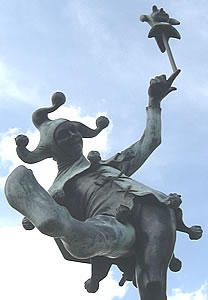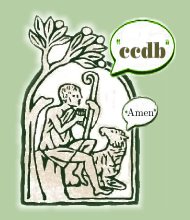"The Foolish are Coming! The Foolish are Coming!"
Reasonable Elites see an 'American Theocracy':
Kevin Phillips rose to prominence on the heels of Richard Nixon's political triumphs. His 1969 book The Emerging Republican Majority was hailed as a visionary work of political analysis. But his new book, American Theocracy, argues that the Republican Party -- and the country -- is headed for disaster.Take a look at the slobbering panic in print:
Subtitled "The Peril and Politics of Radical Religion, Oil, and Borrowed Money in the 21st Century," American Theocracy puts the trials of modern America into the context of other great historical powers. From Rome to Great Britain, Phillips identifies the keys to their decline -- and draws parallels to modern America.
In its recent practice, the radical side of U.S. religion has embraced cultural antimodernism, war hawkishness, Armageddon prophecy, and in the case of conservative fundamentalists, a demand for governments by literal biblical interpretation. In the 1800s, religious historians generally minimized the sectarian thrust of religious excess, but recent years have brought more candor. The evangelical, fundamentalist, sectarian, and radical threads of American religion are being proclaimed openly and analyzed widely, even though bluntness is frequently muted by a pseudo-tolerance, the polite reluctance to criticize another's religion. However given the wider thrust of religion's claims on public life, this hesitance falls somewhere between unfortunate and dangerous. Charles Kimball, a North Carolina Baptist and professor of religion, speaks very much to the point: "Although many of us have been taught it is not polite to discuss religion and politics in public, we must quickly unlearn that lesson. Our collective failure to challenge presuppositions, think anew, and openly debate central religious concerns affecting society is a recipe for disaster."1In other words, those scary Fundamentalists dare to think Christ has something important to say to our Reasonable society. O the Humanity!
Still, the challenge is gathering. Academic projects that spotlight the resurgence of religious fundamentalism around the world now routinely include the United States, along with India, Israel, and many Islamic countries. Scholars have always touched on "militantly anti-modernist Protestant evangelicalism," but there is a renewed focus.2 Some moderate-toliberal theologians have begun to challenge half-baked preaching about the rapture and the end times as "a toxin endangering the health -- even the life -- of the Christian churches and American society."3 Suburban megachurches, in turn, find themselves explained as offering the spiritual equivalent of a shopping mall: would you like psychic healing today, Hindu breathing exercises, or just a little observant mood music?4 Ultimately, the larger political resurgence of historically controversial religiosity is what demands attention.
Evangelical, fundamentalist, and Pentecostal denominations began the new millennium verging on juggernaut status. To the surprise of some observers, the sectarianism and fragmentation of American Christianity remained as visible at the turn of the twenty-first century as they had been one hundred years earlier. A consensus on this development is taking shape, as we will see. The old mainline churches have been culturally and institutionally displaced by a new plurality; yesteryear's supposed fringes are taking over American Protestantism's main square.
Documentation is far from perfect, and statistics can be as misleading or obscure in this realm as in any other. The half dozen or so periodic religious surveys, membership directories, and atlases of religion published in the United States are useful but incomplete, in part because of the unwillingness of many small and midsized denominations to participate in religious samplings. The Atlas of Religious Change in America, 1952–1990 begins with several pages to explain its methodologies and omissions. In a nutshell, only 80 to 85 percent of religious adherents were included because scores of churches, mostly white conservative or black, did not cooperate or submitted unsatisfactory data.5 Fully presenting them would only enlarge the biblical and conservative predominance.
In contrast to the secular and often agnostic Christianity dominant in Europe, Canada, and Australia, the American view encompasses a very different outlook -- one in which a large minority is in key ways closer to the intensity of seventeenth-century Puritans, Presbyterian Covenanters, and earlier Dutch or Swiss Calvinists. As we will see, these are not comforting analogies. The world's leading economic and military power is also -- no one can misread the data -- the world's leading Bible-reading crusader state, immersed in an Old Testament of stern prophets and bloody Middle Eastern battlefields.
There is, to be sure, a large and growing secular culture in the United States. Among northern university graduates and cultural elites, it is dominant -- stronger by far than that of the biblical and salvationist contingent. However, the Republican coalition and administration of George W. Bush is heavily weighted toward the 30 to 40 percent of the electorate caught up in Scripture and the prospect of being suddenly transported to God's side. This is enough to push the United States toward what chapter 6 will posit as a national Disenlightenment. Indeed, American foreign policy has its own corollary to the end-times worldview: the preemptive righteousness of a biblical nation become a high-technology, gospelspreading superpower.
Meanwhile, he reveals his oh-so-well informed sensibilities on the nuances of religion here:
Although Stark and Finke do not hypothesize the "Protestantization" of American Catholicism, they do promote an analogy between weakening faiths.72 Because Catholics can marry non-Catholics, can set foot in other churches, and can miss mass without thereby committing a sin, less is being demanded of them, and less loyalty is being returned.Funny, now maybe it's me, but since when did the Second Vatican Council do away with the third commandment? Oh, that's right, it didn't:
2192 "Sunday . . . is to be observed as the foremost holy day of obligation in the universal Church" (CIC, can. 1246 § 1). "On Sundays and other holy days of obligation the faithful are bound to participate in the Mass" (CIC, can. 1247).I wonder what else he got wrong?
The mouth-foaming of the Reasonable about the coming Theocracy impresses no one else. Least of all Fools. They must live truly boring lives to crave such Chicken-Little-esque excitement. Yawn.





















<< Home